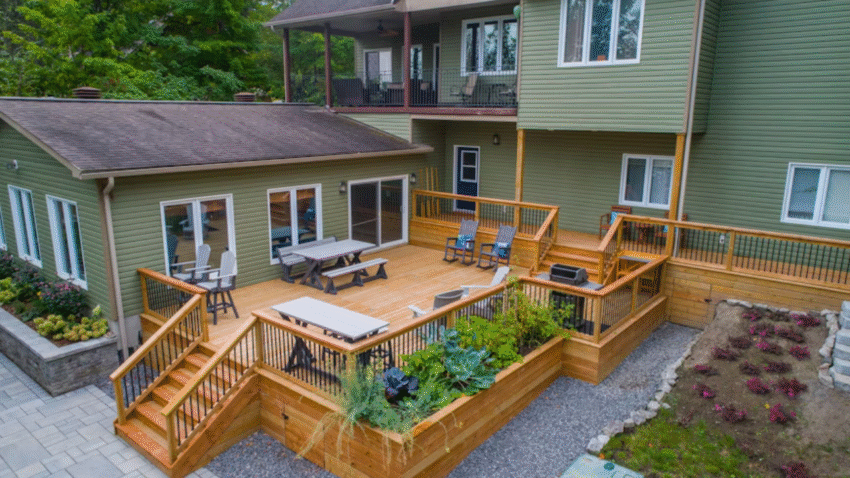Introduction
Wooden decks add beauty and function to outdoor living spaces, but exposure to sun, rain, and temperature changes can cause boards to warp, cup, or twist. Warped boards not only ruin the look of your deck but also create tripping hazards and weaken the overall structure. Learning how to replace warped decking boards restores safety, durability, and appearance, keeping your deck ready for years of enjoyment.
Why Replacing Warped Boards Matters
Replacing warped boards is more than cosmetic—it’s a key part of deck maintenance:
- Safety: Warped boards can trip guests or catch bare feet.
- Structural Integrity: Replacing damaged boards maintains overall strength.
- Longevity: Prevents warped boards from pulling on fasteners and affecting nearby boards.
- Curb Appeal: Smooth, level decking looks far more inviting.
By addressing warped boards promptly, you extend your deck’s lifespan and avoid bigger, more costly repairs.
Step-by-Step Guide to Replacing Warped Decking Boards
1. Gather Tools and Materials
You’ll need:
- Replacement decking boards (same size and material as existing)
- Tape measure and carpenter’s pencil
- Circular saw or handsaw
- Pry bar or drill for removing fasteners
- Galvanized screws or nails
- Drill/driver and bits
- Safety gear: gloves, goggles, ear protection
Optional: Wood preservative, stain, or sealant for finishing the new boards.
2. Inspect and Identify Warped Boards
- Walk across the deck and mark warped, cupped, or twisted boards.
- Look for boards that are loose, cracked, or splintered—they should also be replaced.
- Measure the length and width of the boards to match replacements.
3. Choose Replacement Boards
- Use pressure-treated lumber, cedar, redwood, or composite boards to match your existing deck.
- Check for straightness before purchase—avoid boards with visible bowing or twisting.
- If possible, buy extra boards for future repairs.
4. Remove the Damaged Boards
- Use a pry bar or drill to remove screws/nails holding the board in place.
- Start at one end and work along the board to avoid damaging adjacent boards.
- For stubborn boards, cut them into smaller sections with a circular saw to make removal easier.
5. Inspect Joists and Supports
- Once the board is removed, inspect the underlying joists.
- Look for rot, mold, or loose fasteners.
- Replace or reinforce weak spots before installing new decking.
6. Cut Replacement Boards to Size
- Measure the space where the new board will go.
- Cut the replacement board slightly shorter (about 1/8 inch) to allow for expansion.
- Smooth cut ends with sandpaper to prevent splinters.
7. Position the New Board
- Place the board in the gap, ensuring even spacing with adjacent boards (about 1/8 inch for drainage).
- If boards are tight, use a flat bar or clamps to maneuver them into place.
8. Secure the Board
- Drill pilot holes to prevent splitting.
- Fasten with galvanized deck screws or nails, driving them flush with the board surface.
- For a cleaner look, consider hidden fasteners if compatible with your deck design.
9. Blend and Finish
- Apply wood preservative to cut ends for protection.
- Stain or seal the new board to match the rest of the deck.
- If your deck is due for refinishing, consider sanding and sealing the entire surface for a uniform appearance.
10. Inspect and Maintain Regularly
- Walk the deck after installation to ensure stability.
- Perform seasonal inspections to catch early signs of warping, cracks, or loose boards.
- Reseal or restain the deck every 1–2 years for protection.
Common Mistakes to Avoid
- Mistake: Using Non-Treated Lumber
Untreated boards rot quickly outdoors.
Solution: Always use pressure-treated or weather-resistant wood. - Mistake: Forgetting Expansion Gaps
Tightly fitted boards swell and warp.
Solution: Leave 1/8 inch gap between boards for drainage and airflow. - Mistake: Skipping Joist Inspection
Replacing boards without checking joists ignores potential hidden issues.
Solution: Always inspect supports before installing new decking. - Mistake: Mismatched Boards
Different wood types or sizes stand out visually and structurally.
Solution: Match board size, type, and finish to the existing deck. - Mistake: Using Wrong Fasteners
Indoor screws or nails corrode outdoors.
Solution: Use galvanized or stainless-steel fasteners for durability.
Extra Patio & Deck Tips & Hacks
- To prevent future warping, store extra boards flat and shaded before use.
- For minor cupping or twisting, try flipping the board before replacing—it may straighten with weight.
- Apply sealant to both sides of replacement boards before installation for extra moisture resistance.
- Keep deck clear of standing water by ensuring proper drainage and slope.
- Trim overhanging tree branches to reduce moisture buildup and shade that accelerates warping.
Want more repair tips? See our guide on how to fix a sagging wooden deck.
Conclusion
Learning how to replace warped decking boards is a simple but essential part of deck maintenance. By removing damaged boards, inspecting supports, and installing properly sized replacements, you restore safety, stability, and beauty to your outdoor living space.
Pro tip: Consistency is key—inspect your deck every season, replace warped boards promptly, and reseal the surface regularly to keep your deck in top condition. Bookmark this guide to keep your deck looking and performing its best year after year.
